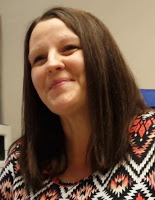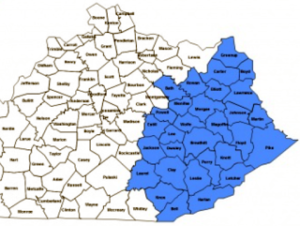This story was reported by CHMP Media Fellow Melissa Patrick and first appeared on the Kentucky Health News website.
BEATTYVILLE, Ky. – Fannie Callahan, a 62-year-old woman from Lee County, worked at the local nursing home for 38 years before retiring, has insurance, and pays her bills on time. But a six-day hospital stay in 2013 left her thousands of dollars in debt and wondering how to pay it and also cover her basic needs – until a co-worker told her about Kentucky Homeplace.

Samantha Bowman, CHW
Samantha Bowman, a community health worker at Homeplace, said she was able to call Fannie’s bill collectors and get the debts written off or reduced, then helped her create a payment plan within her budget.
“I was in distress and really didn’t know which way to turn,” Callahan said. “I don’t know what I would do without Kentucky Homeplace.”
For more than 20 years, Kentucky Homeplace has used community health workers to get thousands of Kentuckians the services they need. Most of its clients are either at or near the poverty level, but the program is free to anyone in the 30 Eastern Kentucky counties it serves.
CHWs aren’t medically trained, but come from the communities they serve and are trained patient advocates who help coordinate their clients’ care, provide access to medical, social and environmental services, and deliver education on prevention and disease self- management.
Homeplace is part of the University of Kentucky‘s Center of Excellence in Rural Health. CERH Director Fran Feltner said preventive screening rates are higher for Homeplace clients than state and national averages “because the CHWs really work with them to make sure they get screened.”
The mammogram rate is 89 percent, far above the state’s 58 percent and the nation’s 60 percent.
Bowman said the greatest needs for her clients are medical, and she often helps them get medical supplies.

Counties served by Kentucky Homeplace are in blue
“We see those working-poor individuals or even middle-income individuals that come in here that
have tried other avenues without success,” she said. “They are working 40, 50, 60 hours a week, but the income is not enough for them to be able to afford to access the care they need, whether it’s glasses, dentures, hearing aides, medications, or even diabetic shoes — they can’t afford to get them.”
Bowman said she also helps her clients become better health consumers, noting that many leave their doctor’s office without a real understanding of their diagnosis or what they need to do about it.
“The majority of them can’t work through the medical system, it’s too difficult. They don’t understand, most of the time, even the medications they take,” Bowman said.
“So Homeplace makes a huge difference in looking at the person as a whole and starting from that beginning screening to know what the person really needs. Is it that they need food? Is it that they need shelter? And then when you get those goals met, then you can talk to them about preventive care,” Feltner said. “The success is that holistic approach that we take to take care of the people.”
CHW and similar programs vary across the state
The Montgomery County Health Department’s CHW program, called “The Bridge” (or “El Puente” for Latino clients) is clinic-based and focuses on chronic-disease management.
Gina Brien, director of the agency’s Community Department, said surveys of clients show that they are more able to manage their at-risk or chronic conditions, have better health status and have reduced emergency-room visits and overnight hospital stays.
The Barren River District Health Department uses CHWs and registered nurses in a “self-management program” and only accepts clients who have heart failure, diabetes and chronic obstructive pulmonary disease.
Cara Castleberry, manager of the Community Health Management Program, said one of its program’s many successes in the past year has been an average drop of 2.15 percent in their patients’ A1C, a test for blood sugar.
The Mountain Comprehensive Health Corp. in Whitesburg uses registered nurses as quality care managers to coordinate care and improve patients’ health behaviors. The program requires patients to have two chronic health conditions and is covered by Medicaid. Care managers provide many of the same services as CHWs, but are also able to manage their patients’ health conditions.
“We’ve seen A1Cs go down. We’ve seen patients who never come in for preventive exams who have come in for preventives. I had a patient who hadn’t had a pap[smear for cervical cancer] in 15 years . . . and she was just too scared to talk to somebody about the fact that she was afraid that she couldn’t step up on that bed,” said manager Chalena Williams.
Most CHW programs in Kentucky are rural, but the Louisville Urban League recently launched a CHW program, “It Starts with Me,” in four neighborhoods in west Louisville, which have some of the greatest health disparities in the city.
“What we are finding with many of our clients is that there is a gap between what a medical provider — or really any type of organization that they are interfacing with — is asking them to do and then what they are understanding,” said Lyndon Pryor, the league’s health program manager.
Pryor said providers think they are being straightforward about recommending medications, but fail to realize patients don’t know how to get them through their insurance, or don’t have transportation to get to the pharmacy, or that work conflicts keep them from complying with the instructions.
“CHWs are able to sift through all of the different nuances of a person’s life and figure out how to get to the best solution possible for the individual,” Pryor said.
The future of CHWs in Kentucky
CHWs are becoming an integral part of a health system that is increasingly focused on outcomes and the social determinants of health.
Kentucky’s CHW Workgroup, led by the state Department for Public Health, and the state’s Community Health Worker Association are working on a certification process for CHWs, in hopes of increasing funding options, which would allow the program to expand.
Insurance rarely covers CHW services. Kentucky’s CHW programs are funded by various sources, including the state’s general fund, grants and local taxes.
Brien, a member of the workgroup, said it started meeting in 2012 and made progress, but last year’s change in administrations has required them to educate the new health officials. Nationally, a formal task force is working on a framework for sustainable, effective CHW programs.
The Bureau of Labor Statistics says Kentucky had between 390 and 560 CHWs in May 2015, the latest data available. Nationally, there were about 48,000.
Feltner said Kentucky needs more CHW programs because there are areas all over the state with great health disparities that would benefit from them: “If you don’t remove those barriers and those social determinants of health, you have a sick population.”
This article was produced as part of the Health Care Workforce Media Fellowship, run by the Center for Health, Media & Policy, New York, N.Y. The fellowship is supported by a grant from the Johnson & Johnson Foundation. Kentucky Health News is an independent news service of the Institute for Rural Journalism and Community Issues, based in the School of Journalism and Media at the University of Kentucky, with support from the Foundation for a Healthy Kentucky.
This story was reported by CHMP Media Fellow





